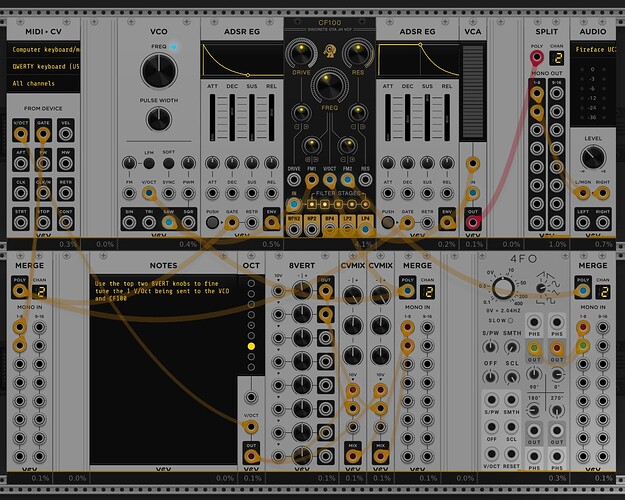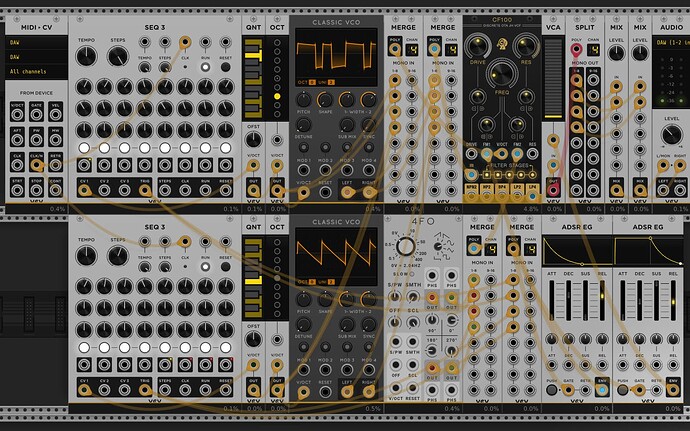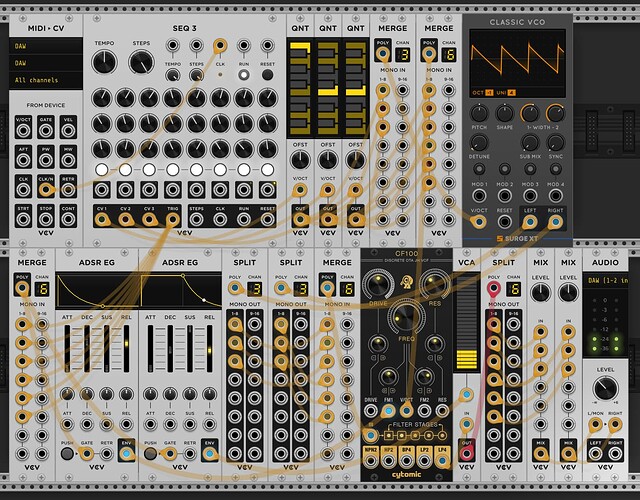My vinyl collection is well down from its peak of 4000 albums. I keep them in good shape, very little noise or crackles.
Future Farmers! ![]()
Funky! And a good story too ![]()
I was reading on another forum recently about somebody who gets great cello sounds out of spring reverb feedback. Mine picks up a lot of noise, but it can be hard to control it. You did a great job using it there.
You’re just not doing enough scratching on the decks with them Bruce ![]()
That’s true, no “wheels of steel” for me. Wouldn’t have worked on my old air bearing sprung sub chassis belt drive. Wouldn’t work well on my current one, either.
Well, for an announcement this thread has gone slightly off topic but in a really interesting way!
Anyway, I finished my video on the CF100. It features five sounds I discovered that I quite liked. I’ll upload the patches later on.
Hope you don’t mind me spamming it here. It really is a very characterful filter.
Cheers,
Ed
This is exactly the right place to post your vid, great patching Ed!
If anyone else has created some patches and wants to share a video please do and post it here so there is a collection all in one place ![]()
I appreciate the comment about being characterful - I consider this to be “analog behaving and sounding” apart from perhaps the lack of detail in the noise modelling, but for regular operation definitely. If at any stage you get into hardware Eurorack and buy some filters I’m sure you’ll come to recognise this, there are so many great sounding analog filters out there.
In software when someone says they have “modelled” a circuit it’s pretty much useless them saying that because you still have zero understanding or knowledge of exactly how much detail there is in the model, since they could well have used any technique, no matter how inaccurate, and still say they “modelled” the circuit. An easy to understand example of this would be using a straight line to “model” the shape of a circle - it’s totally valid in some circumstances to do this, if you zoom up really close on a small part of the circle it is indeed fairly straight. It’s just a really bad model of the entire structure of the circle, so completely useless for most things where what you wanted was a circle.
Glorious sounds Ed, good stuff!
Thanks Lars, and Andy for that insight into the modelling process. You’re absolutely right, with the standard waveforms used in subtractive synthesis at least, the filter is what largely defines the sound. I’m not planning to get into Eurorack any time soon (although that can change!), but the point also applies in VCV, the same VCO can sound completely different patched into another filter.
I’ve uploaded all the patches now, if anyone finds this useful - links are also in the description on the video.
I appreciate this tip (using merge split for stereo) but it work best with mono stereo. But merging poly stereo makes it impossible to associate the poly modulation with the poly filters per voice. I’ve started patching 2 filters to get full expressive sound with poly modulation and poly key tracking. Super sounding synth filter!!!
If a module is poly and CV controllable for everything you want to change, then you can use devices like VCV 8-vert + merge, or the Bogaudio Polycon 16 / PolyOff 16, and then you get a knob per channel per thing you want to vary. Having two instances will be fine for stereo, and also is the only option if you want stereo with 16 voices, but it is more efficient to use a single device with multiples of 2 or 4 voices for poly devices since they normally use f64x2 or f32x4 SIMD to compute then efficiently in parallel.
I guess the one that kept me guessing was per voice key tracking, once I merge it’s really gone, and other modules could help, but doubtful it’s as good as the simple v/oct tracking you already designed. I simply adore the sound of this filter, very rich and satisfying, thank you kindly.
The 1 V/Oct poly CV output from MIDI to CV works like any other poly CV, you can plug it into a poly 1 V/Oct device and get keytracking from that osc / filter etc. What problem are you having? Is it detuning? You can use the Split module to break out each voice into its own CV, then alter them as per my previous post, then merge them again. There are also dedicated “spread” type modules for this.
I’m taking a stereo polyphonic signal and merging into one cable, I’m sending the poly volt per oct straight to filter , guess I should duplicate and merge this as well and try that to volt per oct first. I just did not keep the per voice association with the merged poly stereo and the v/oct used for key tracking. It made muddy not key tracked stuff.
Ahh, I see. You want unison of two voices to make stereo but all tracked off a single mono midi input? The MIDI-CV converter doesn’t have this feature, I have added it to a git repository and encouraged Andrew Belt to add this to the MIDI-CV device, but that will take some time.
I’ve made a patch to help get you started, it uses the Cytomic CF100, and the Bogaudio 4FO, and then all built in VCV Rack modules. The first two 8Vert knobs offset the 1V/Oct signal of the two channels, and the 4FO provides a 90 deg out of phase sin wave to swirl the filter cutoff.
cf100 stereo bass.vcv (2.4 KB)
ok thats the idea, but I was using a VCV sequencer for pitch ( horse a doodle doo can output different cv streams in a polyphonic fashion) usually just 3or 4 voices, when I use 2 filters its easy peasy to track v/oct that is specific to each voice, in this sequencer these voices are not always at the same time, you can get a nice broken chord effect because of the variations on each voice of polyphony, and your filter can track all this voice movement perfectly.
I make this into audio with surge xt vcos of several variety, they output stereo and allow a lot of fun movement right at the oscillator ( drift, unison detune with stereo spread, etc), when this gets merged I dont get 6 voices of poly, but 2. So maybe I misunderstand the use of merge here, I don’t think it is possible to create a stereo poly signal merged that has all the voices available in their own channel so they can be key tracked at the filter when combined into one cable. I’m sure someone sees the answer, but I’m satisfied using 2 filters side by side, because then everything is happy happy.
You can merge and split any combination of cv and audio you want up to a total of 16 channels, including two stereo channels for the cf100 to process as 4 total channels.
Here is a patch that uses two surge osc, each with unison of 2 that outputs stereo, and then these two sets of stereo are merged into a 4 channel poly cable, along with two sets of 1V/Oct CV.
cf100 dual stereo.vcv (4.0 KB)
You could do all this with just a single surge osc if you really wanted. Pretty much anything is possible if the device has poly cv input for the thing you want to control.
Here is a patch with a single step sequencer driving 3 channels of pitch, then the surge VCO having 4 voices of unison, panned into three poly sets of stereo, which are merged into 6 channels, 3 left then 3 right, along with the key tracking 1V/Oct and processed in a single copy of the CF100, when is then split back out to be hard panned left and right. So this uses 6 channels of polyphony inside the CF100, and the envs and amps with 3 sets of stereo 1V/Oct keytrack:
cf100 triple stereo.vcv (3.6 KB)
@cubistguitar I think the trick you were missing was to first split the each of the three channels of left and right poly back to mono, then merge them all into a six channel poly cable.
sengpielaudio.com is such a great site for calculators, I love its outdated web aesthetic and straightforward utility. RIP Eberhard Sengpiel, and thanks for all the resources!
I was about to say that somebody ought to have given him a Grammy for that too, but then I checked his wikipedia and saw he won a Medal of Honor in 2010 from the Association of German Sound Engineers for outstanding services to the profession, which feels like it sums it up just about right.
I’ve done some basic noise modelling, just adding some hiss to various currents inside the model where it matters most, both pink and gaussian white noise. Can people have a little listen and let me know which one you think sounds best? I’ve got the two options in a stereo mp3, amplified up so it’s obvious, with no audio at the input, and medium resonance doing some down sweeps. So does the left or right channel sound better?
https://cytomic.com/files/forums/cf100-noise-test.mp3
- Left sounds best
- Right sounds best
- Either is fine
- Both sound bad



